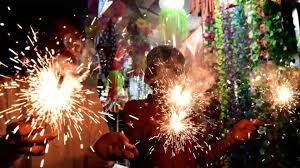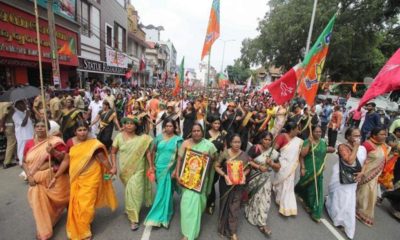Feature
Like Sabarimala, this Kolkata Kali Puja prevents women’s entry

Amidst the raging controversy surrounding Kerala’s Sabarimala temple, a 34-year-old Kali Puja here is now getting media attention as it doesn’t allow women to step inside the marquee premises, with belief reigning stronger than rights.
“Our 34-year-old Panchamunda Kali Puja follows tantra (an ancient esoteric Hindu tradition). Tantric priests from Tarapith have been conducting the Puja every year. We had questioned our ancestors, but they said a female is not even allowed to touch anything,” Gangaram Shaw, executive body member of the Chetla Pradip Sangha, told .
Kali Puja — which is celebrated as Diwali in Bengal — is scheduled to be held on November 6.

Shaw mentioned that the restriction on entry has been there ever since the Puja was first held. Another committee member, Manoj Ghosh, said: “As organisers, we want women to be included in the Puja but this is not our Puja as we have to follow whatever the tantrics say.”
However, a priest of Tarapith temple (265 km from Kolkata), situated on the banks of the Dwarka River in Birbhum district, expressed immense surprise. Tarapith is famous for its tantric practices.
“I am one of the aged priests here and I know there are no such rules that prevent the entry of women. Our temple is open for all and I am wondering who are those priests talking about such restrictions,” exclaimed Mulmantra Roy, 81.
The community Puja, with a budget of around Rs 300,000, is a major crowd-puller and, this year, the organisers plan to bring their 15-feet-tall idol on November 4. The immersion will take place on November 9.
But they simply plead helplessness over bringing about any change with regard to the restriction.

“People come in large groups and the ground that you can see beside the marquee helps in managing the crowd. We allow them to worship from outside. The restriction is really surprising as the Goddess herself is a woman, but it cannot be changed,” Gangaram said.
Commenting on the reason cited by the organisers, Indologist Nrisingha Prasad Bhaduri said: “This is particularly a patriarchy-induced condition. Most of the Shakti Pujas are done following the tantra rituals and such practice is not prevalent anywhere. Finally, if the tantric has so many problems, then why are they worshipping the female goddess?”
“This is not logical and they are projecting a sort of vainglory,” Bhaduri affirmed.
The women residents of the area seem least bothered about the restrictions as they don’t want to break the age-old tradition.
“I have seen this Puja when it started during my childhood days. Women can be part of the procession of bringing the idol and also join the visarjan (immersion procession). But once the rituals of the Puja begin, we cannot step inside the pandal. This has been the rule and we have followed it with devotion,” Mithu Mantri, a woman resident said.
Entertainment
Meghalaya Reserves Legalized Gambling and Sports Betting for Tourists

The State Scores Extra High on Gaming-Friendly Industry Index
Meghalaya scored 92.85 out of 100 possible points in a Gaming Industry Index and proved to be India’s most gaming-friendly state following its recent profound legislation changes over the field allowing land-based and online gaming, including games of chance, under a licensing regime.
The index by the UK India Business Council (UKIBC) uses a scale of 0 to 100 to measure the level of legalisation on gambling and betting achieved by a state based on the scores over a set of seven different games – lottery, horse racing, betting on sports, poker, rummy, casino and fantasy sports
Starting from February last year, Meghalaya became the third state in India’s northeast to legalise gambling and betting after Sikkim and Nagaland. After consultations with the UKIBC, the state proceeded with the adoption of the Meghalaya Regulation of Gaming Act, 2021 and the nullification of the Meghalaya Prevention of Gambling Act, 1970. Subsequently in December, the Meghalaya Regulation of Gaming Rules, 2021 were notified and came into force.
All for the Tourists
The move to legalise and license various forms of offline and online betting and gambling in Meghalaya is aimed at boosting tourism and creating jobs, and altogether raising taxation revenues for the northeastern state. At the same time, the opportunities to bet and gamble legally will be reserved only for tourists and visitors.
“We came out with a Gaming Act and subsequently framed the Regulation of Gaming Rules, 2021. The government will accordingly issue licenses to operate games of skill and chance, both online and offline,” said James P. K. Sangma, Meghalaya State Law and Taxation Minister speaking in the capital city of Shillong. “But the legalized gambling and gaming will only be for tourists and not residents of Meghalaya,” he continued.
To be allowed to play, tourists and people visiting the state for work or business purposes will have to prove their non-resident status by presenting appropriate documents, in a process similar to a bank KYC (Know Your Customer) procedure.
Meghalaya Reaches Out to a Vast Market
With 140 millions of people in India estimated to bet regularly on sports, and a total of 370 million desi bettors around prominent sporting events, as per data from one of the latest reports by Esse N Videri, Meghalaya is set to reach out and take a piece of a vast market.
Estimates on the financial value of India’s sports betting market, combined across all types of offline channels and online sports and cricket predictions and betting platforms, speak about amounts between $130 and $150 billion (roughly between ₹9.7 and ₹11.5 lakh crore).
Andhra Pradesh, Telangana and Delhi are shown to deliver the highest number of bettors and Meghalaya can count on substantial tourists flow from their betting circles. The sports betting communities of Karnataka, Maharashtra, Uttar Pradesh and Haryana are also not to be underestimated.
Among the sports, cricket is most popular, registering 68 percent of the total bet count analyzed by Esse N Videri. Football takes second position with 11 percent of the bets, followed by betting on FIFA at 7 percent and on eCricket at 5 percent. The last position in the Top 5 of popular sports for betting in India is taken by tennis with 3 percent of the bet count.
Local Citizens will Still have Their Teer Betting
Meghalaya residents will still be permitted to participate in teer betting over arrow-shooting results. Teer is a traditional method of gambling, somewhat similar to a lottery draw, and held under the rules of the Meghalaya Regulation of the Game of Arrow Shooting and the Sale of Teer Tickets Act, 2018.
Teer includes bettors wagering on the number of arrows that reach the target which is placed about 50 meters away from a team of 20 archers positioned in a semicircle.
The archers shoot volleys of arrows at the target for ten minutes, and players place their bets choosing a number between 0 and 99 trying to guess the last two digits of the number of arrows that successfully pierce the target.
If, for example, the number of hits is 256, anyone who has bet on 56 wins an amount eight times bigger than their wager.

















